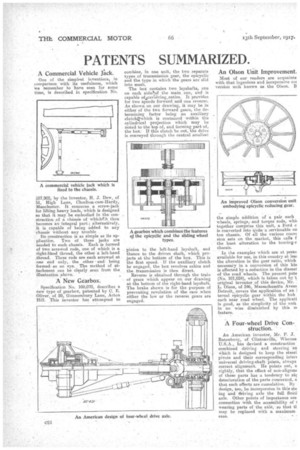PATENTS SUMMARIZED.
Page 22

If you've noticed an error in this article please click here to report it so we can fix it.
A Commercial Vehicle Jack.
One of the simplest inventions, in comparison with its usefulness, which we remember to have seen for some time, is described in specification No.
107,902, by the inventor, H. J. Dew, of 51, High Lane, Chorlton-cum-Hardy, Manchester. It concerns a screw-jack for lifting heavy loads, which is designed so that it may be embodied in the construction of a chassis of whiclrrit then becomes an integral part; alternatively, it is capable of being added to any chassis without any trouble . Its construction is as simple as its application. Two of these jacks are 'needed to each chassis. Each is formed of two screwed rods, one of which is a right-111ml thread, the other a left-hand ,thread. These rods are each screwed at one end only, the other endbeing formed as an eye. The method of attachment can be clearly seen from the illustration above.
A New Gearbox.
Specification No. 108,070, describes a new type of gearbox, patented by C. E. Oliver, of 59, Gunnersbnry Lane, Acton Hill. This inventor has attempted to combine, in one unit, the two separate types of transmission gear, the epicyclic and the type in which the gears are slid into mesh.
The box contains two layshafts, one on each side,' of the main, one, and is capable ofarevolving,entire. It provides for two speeds forward and one reverse. As shown on our drawing, it may be in either of the two forward gears, the determining factor being an auxiliary clutchewhich is contained within the cylindrical projection which may be noted to the top of, and forming part of, the box. If this clutch be oat, the drive is conveyed through the central smallest pinion to the left-hand layshaft, and thence to the driven shaft, which projects at the bottom of the box. This is the first speed. If the auxiliary clutch be engaged, the box revolves entire and the transmission is then direct, Reverse is obtained through the train of gears which appear on our drawing at the bottom of the right-hand laysh aft. The brake shown is for the purpose of preventing revolution of the case when either the low or the reverse gears are engaged.
An Olson Umt Improvement.
Most of our readers are acquaints with that ingenious and inexpensive cor version unit known as the Olson. B the simple addition of a pair each wheels, springs,. and torque rods, whit together comprise this unit, a Ford c is converted into quite a serviceable on ton chassis. Of all the various convc sion sets on the market, this calls f the least alteration to the touring-c chassis.
In the examples which are at press available for use, in this country at leat the alteration in the gear ratio, which necessary in a conversion of this kin is effected by a reduction in the diainet of the road wheels. The present pate (No. 101,024), which is taken out by original inventor,of this device, Mr. : L. Olson, of 246, Massachusetts Avent Detroit, covers the application of an i ternal epicyclie gear within the hub each near road wheel. The applicati is good, as the simplicity of the unit in no wise diminished by this ni feature.
A Four-wheel Drive Con-.
. struction.
An American inventor, Mr. P. J. Batenburg, of Clintonville, Wiscons U.S.A., has devised a construction combined driving and steering ax which is deSigned to keep the steer pivots and their corresponding interi universal driving-shaft joints, always correct alignment. He points out, a • rightly, that the effect of non-alignm< of these parts has a tendency to raj deterioration of the parts concerned, a that such effects are cumulative. By : design, too, he incorporates in this ste ing and driving axle the fall floati axle. Other points of importance are connection with the accessibility of i wearing parts of the aide, so that tt may be replaced with a maximum ease. ,






















